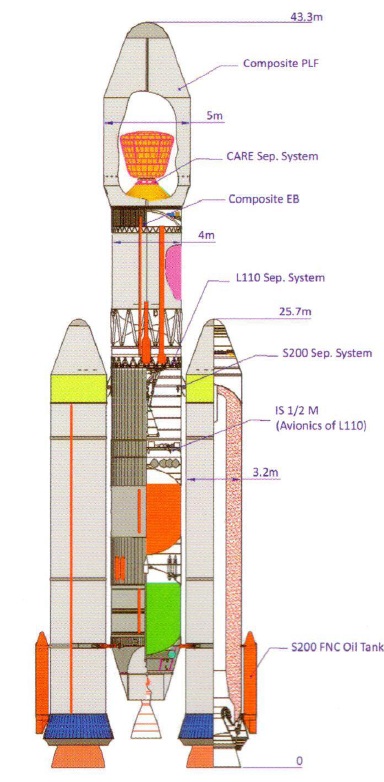Copyright 2024 Robert Clark
In the blog post, "A liquid-fueled Indian manned launcher. UPDATED", I suggested the launcher based on the liquid-fueled LVM3 core stage, but replacing the 2 solid side boosters by 4 of the liquid-fueled strap on boosters used on the earlier design, the GSLV Mk. II. Here I'll suggest instead a version using the LVM3 core but getting the added thrust needed for lift-off by adding a 3rd Vikas engine.
GSLV Mk. III Specifications
Core Stage
| Type | L-110 | |
| Length | 21.26m | |
| Diameter | 4.0m | |
| Fuel | Unsymmetrical Dimethylhydrazine | |
| Oxidizer | Nitrogen Tetroxide | |
| Inert Mass | 10,600kg | |
| Propellant Mass | 115,000kg | |
| Launch Mass | 125,600kg | |
| Propellant Tanks | Aluminum Alloy | |
| Fuel | UH25 - 75% UDMH, 25% Diazane | |
| Oxidizer | Nitrogen Tetroxide | |
| Propulsion | 2 Vikas 2 | |
| Thrust (SL) | 677kN | |
| Thrust (Vac) | 766kN | |
| Specific Impulse | 293 sec | |
| Engine Dry Weight | 900kg | |
| Engine Length | 2.87m | |
| Engine Diameter | 0.99m | |
| Chamber Pressure | 58.5bar | |
| Mixture Ratio | 1.7 (Ox/Fuel) | |
| Turbopump Speed | 10,000rpm | |
| Flow Rate | 275kg/s | |
| Area Ratio | 13.88 | |
| Attitude Control | Engine Gimbaling | |
| Ignition | T+110s | |
| Burn Time | 200s | |
| Stage Separation | Active/Passive Collets |
The Vikas 2 engine provides a thrust of 677 kN at sea level, 69 tons-force. The two on the core would be enough just to loft the core only. But we need enough thrust to liftoff a second stage and payload also. So we'll give the core a third Vikas engine.
The weight of the Vikas is 900 kg. Then the dry mass of the stage with an additional Vikas will be 11,500 kg.
Cryogenic Upper Stage
| Type | C-25 Cryogenic Upper Stage | |
| Length | 13.32m | |
| Diameter | 4.0m | |
| Fuel | Liquid Hydrogen | |
| Oxidizer | Liquid Oxygen | |
| Inert Mass | ~4,000kg | |
| Propellant Mass | 25,000kg | |
| Launch Mass | ~29,000kg | |
| Propellant Tanks | Aluminum Alloy | |
| Propulsion | CE-20 | |
| Engine Type | Gas Generator | |
| Thrust - Vacuum | 200kN | |
| Operational Range | 180-220kN | |
| Specific Impulse Vac | 443s | |
| Engine Mass | 588kg | |
| Chamber Pressure | 60bar | |
| Mixture Ratio | 5.05 | |
| Area Ratio | 100 | |
| Thrust to Weight | 34.7 | |
| Burn Time | 580s | |
| Guidance | Inertial Platform, Closed Loop | |
| Attitude Control | 2 Vernier Engines | |
| Restart Capability | RCS for Coast Phase |
Now plug in the data for the Silverbirdastronautics.com payload estimator:
Where we assume by just using a nozzle extension the Isp can be raised from 443s to the 465s max Isp of the RL10 engine.
The resulting payload to LEO is:
This is half the 10 ton payload of the current version of the LVM3 with the large solid side boosters. However, it has the advantage of not using the problematical solid side boosters with their safety concerns for manned flights.
The all-liquid version is also likely to be significantly cheaper than the one with solid side boosters as large solid boosters are not price competitive to just using an additional liquid fueled engine.
It is notable a 5 ton class launcher is sufficient to launch a crewed capsule to orbit since the Gemini capsule had a toal mass of 3,800 kg:
GEMINI SPECIFICATIONS
First flight: 8-Apr-1964; first manned flight 23-Mar-1965 (Gemini 3)
Last flight: 11-Nov-1966 (Gemini 12)
Number of flights: 13 total; 10 manned
Principal uses: manned earth orbit rendezvous, docking, EVA tests
Unit cost: $13.00 million
Crew size: 2
Overall length: 5.7 m
Maximum diameter: 3.05 m
Habitable volume: 2.55 m3
Launch mass: 3,851 kg
Propellant mass: 455 kg total
RCS total impulse: 1,168 kNs
Primary engine thrust: 710 N
Main engine propellant: NTO/MMH
Total spacecraft delta v: 323 m/s
Power: fuel cells/batteries; 155.0 kWh total
https://www.braeunig.us/space/specs/gemini.htm
The payload to LEO also can be increased by weight optimizing the first stage. The stage is similar to the first stage of the Titan II that launched the Gemini capsule to space, except the Titan II's first stage dry mass was 6,000 kg less. Reducing the first stage dry mass input in the SilverbirdAstronautics.com payload estimator by 6,000 kg increases the payload to ca. 6,000 kg.
Robert Clark







No comments:
Post a Comment